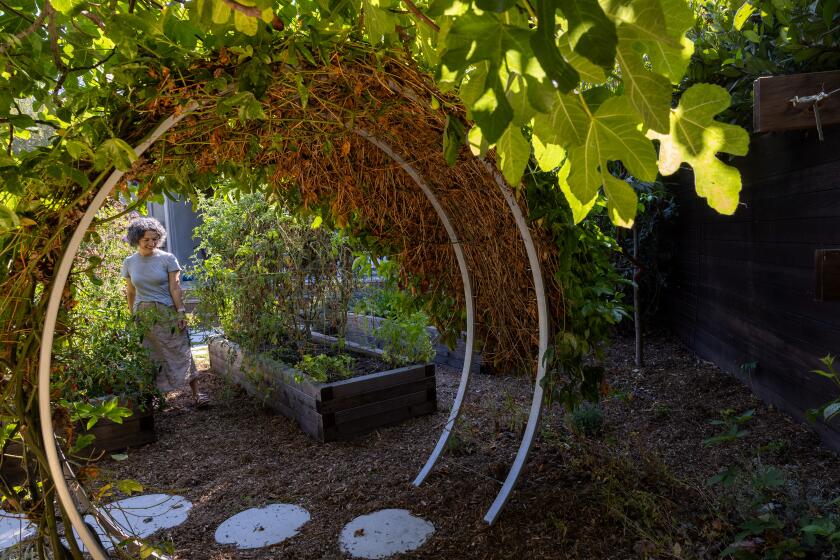Garden ‘Bible’ Gets New Look After 28 Years
Many books about gardening are beautiful and some are inspiring, but are any of them useful?
From this spring’s bumper crop, only a few deserve ribbons in the helpful, how-to category, with the blue ribbon going to the new “Sunset Western Garden Book” (Sunset Publishing, Menlo Park: $29.95, hardcover; $24.95, paper).
This is the first major revision in 28 years to the Southern California classic that has come to be dubbed “the gardener’s bible.” More than a book, it is a tool that gets used and dirty and no closer to the coffee table than a spade or trowel. It resides on the workbench, next to the plant ties and pruning shears.
What makes this book so useful are the maps that divide the West into local climate zones, from 1-24. Suitable zones are suggested for every plant in the 400-page encyclopedic section, so you don’t waste too much effort trying to grow peonies in Palos Verdes (they do best in zones 1-11 and 14-16; Palos Verdes is in zone 23 and 24). Our uniquely mild climate makes this information essential.
A redesign of the plant encyclopedia puts all the important information right at the top of each listing, including the zones, whether the plant needs sun or shade or something in between, and how much water it likes. The plant’s size is almost the first thing mentioned in the text that follows.
All of this is the kind of information you need to check when planning a garden and again at planting time, before committing the plant to the soil, only to find later that it needs full sun, hates being watered and grows twice as big as you thought.
There are many additions to the encyclopedic section, and just in time, since so many new plants have appeared at nurseries in the last few years that are not found in the earlier editions. Added are the “West’s brightest and newest stars”--76 new genera, 168 new species and “countless new strains and varieties.”
For example, the old listing for the genus Salvia contained a dozen species; the new chart-like section contains 30 species, with most of the new cultivars getting a mention. Now you can find out how big that new kind of sage with the pretty pink flowers will grow, and whether it needs water or a dry soil.
Another valuable addition is in the Plant Selection Guide section. Each plant now has its own block of text and cultural symbols, plus a page reference back to the encyclopedia. Many even have a color photo nearby, to jog your memory or inspire a plan.
Typical situations for which plants are suggested include Showy Perennials for Beds and Borders, Plants That Tolerate Shade, Plants That Resist Deer and Plants for Under Oaks.
There is still plenty of basic gardening information, now at the back of the book and organized as a large, well-illustrated glossary, which covers about everything from acid soil to xeriscape, with pests and other problems in between.
Should you replace your soiled old copy with this 40th anniversary edition? Absolutely.
Coming later this spring is a CD-ROM companion that will operate like a giant Plant Selection Guide with photos, which should make it the first useful database for West Coast computer users, though it will never take the place of the book on my bench.
Red ribbons should go to these other spring books:
“Cape Bulbs” by Richard L. Doutt (Timber Press, Portland, Ore.: $34.95). Most of the bulbs from South Africa’s Cape fare far better in our climate than the common narcissus and tulip, flowering reliably year after year with little or no care, even multiplying. Some, such as the freesia, are already well known but these are only the tip of a floral iceberg. Doutt has been growing many of the more exotic in his Santa Barbara garden, and this book is just about the only reference on this exciting group of plants. He is a genuine expert and this is a serious book for serious gardeners who have a weakness for the demurely beautiful. Order by calling (800) 327-5680.
“Pests of Landscape Trees and Shrubs: An Integrated Pest Management Guide,” by the Statewide Integrated Pest Management Project (University of California Publication ANR 3359; $32). This cutting-edge reference, illustrated in color, discusses the latest in pest control for ornamental trees and shrubs, using as little toxic chemicals as possible while relying on natural predators and good cultural practices. There are short sections on how to “design” such a program and how to keep plants healthy (the first line of defense). Much longer sections follow, on insects and other tiny pests, diseases, weeds and nematodes. Problem-solving tables make it all quite easy. Look up eugenia to see what pests plague it and you’ll find a color photo of the notorious psyllid, plus some ideas on how to control it, including a mention of the parasitic wasp introduced from Australia that may bring it under eventual control. To order a copy, call (800) 994-8849.
“California Wildfire Landscaping” by Maureen Gilmer (Taylor Publishing: $10.95). There’s little information on the volatile subject of fire and the planted landscape, a gap Gilmer seeks to fill. Though the suggested-planting lists may sound a little boring, the other ways to ready for fire--from water tanks to the spacing of plants--should help those living in harm’s way. Order by calling (800) 275-8188.
“Bonsai” by Harry Tomlinson (Reader’s Digest Home Handbooks: $16; (800) 793-BOOK). A stunning little book on bonsai, the examples are beautiful and the how-to information extremely detailed and useful. This English book uses many illustrations to explain techniques. Not all of the suggested plants are good choices in our climate. Check the Western Garden Book.





